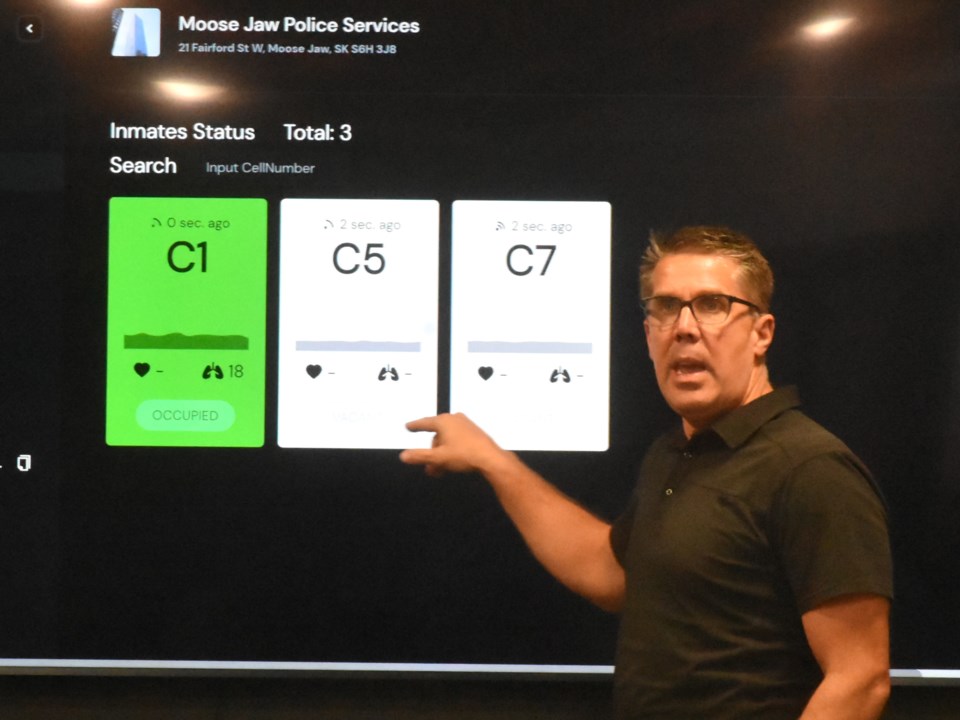MOOSE JAW — The Moose Jaw Police Service (MJPS) has installed new technology in its detention cells to monitor the health and safety of prisoners and potentially prevent emergencies.
Staff Sgt. Cam Lewis spoke about the agency’s biometric scanners during the Board of Police Commissioners’ June 18 meeting. The police service has installed scanners in three of its jail cells, while its goal is to have all 13 rooms outfitted with the technology.
Lewis explained that he learned about the biometric scanners during a visit to the Regina Police Service’s headquarters, where he recognized that they could offer “a significant benefit” to the MJPS. So, he began exploring the possibility of installing them in Canada’s Most Notorious City.
He noted that Xander Kardian, which manufactures the technology, initially created the sensors for the health-care industry to monitor patients. However, it found that the scanners could also serve the policing industry; IT company GT Global installs the sensors for Xander Kardian in Canada.
The MJPS has had every cell wired for the devices and is waiting for budgetary approval to purchase and install the 10 outstanding sensors, the staff sergeant remarked.
The biometric scanners emit 15 million “radar signals” each second, which analyze the vibrations that the human body emits while resting, Lewis continued. By analyzing the vibrations, the sensors capture and display human vital signs continuously and in real-time.
Moreover, the biometric scanners can sense a body’s vibrations through blankets, clothing and furniture.
The MJPS installed the three biometric scanners on June 13 and has been receiving data about prisoners since then. There was one offender in the cells during the police board meeting, which allowed Lewis to discuss some data the sensors were producing.
The sensors showed the prisoner — in cell 1, which is used for detoxification — had a heart rate of 90 beats per minute (BPM) and a breath rate of 16 breaths per minute.
Lewis pointed out that the system is anonymous, so the sensors don’t record personal information about a person. Instead, they simply monitor offenders’ heart and breath rates. The Commissionaires and the watch commander can also review the data and know how the prisoner is doing and whether a cell is occupied.
“The system is designed primarily for (monitoring and measuring) when a person is sleeping or at least pretending to be sleeping,” Lewis said, noting those moments are crucial in knowing whether a prisoner is asleep or “something more sinister” is occurring, such as heart or breath rates that fall outside normal parameters.
The sensors will start screeching if a prisoner’s heart rate is above 150 BPM or below 50 BPM for three minutes straight, or if the breath rate is over 23 breaths per minute or under seven breaths per minute for three minutes straight.
“It’s very sophisticated,” Lewis added.
Acting Chief Rick Johns said that the MJPS’s detention cells are considered high-risk areas, since there may be prisoners who come in on drugs or alcohol or with injuries, which could cause cardiac events or serious medical emergencies.
“We have a very robust policy as to how we check on prisoners with … regular cell checks and arousal checks and visual checks to make sure … our prisoners are doing fine, and we’re able to determine if there’s a concern,” he said. “But this takes it to the next level.”
Johns added that employees look for signs of impairment when prisoners are brought to the cells, while they also thoroughly question the offenders about their health and other related issues.
The next police board meeting is Wednesday, July 16.




